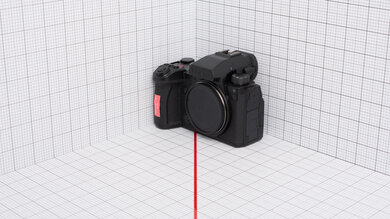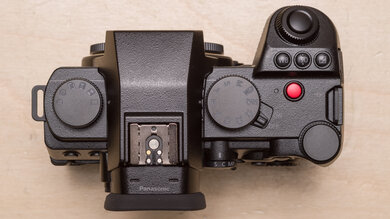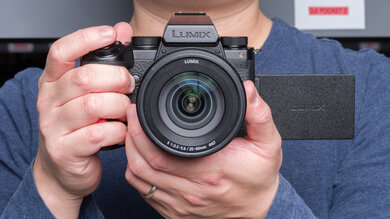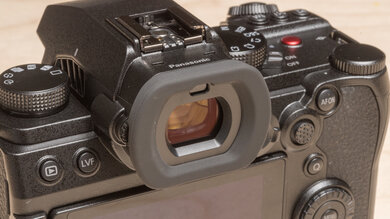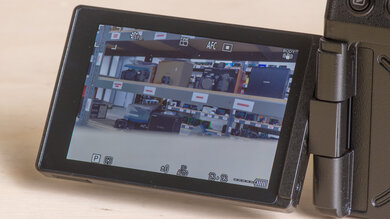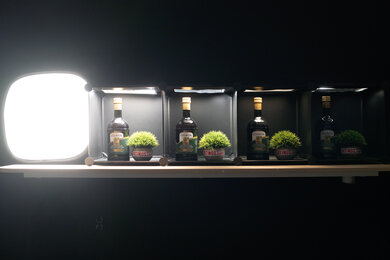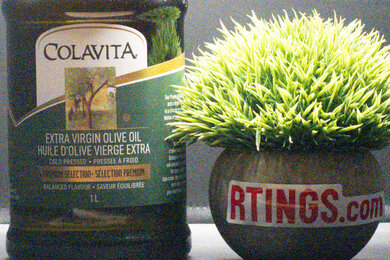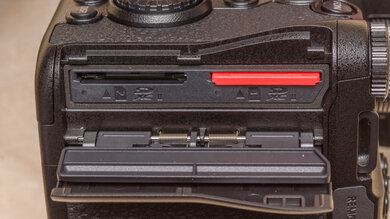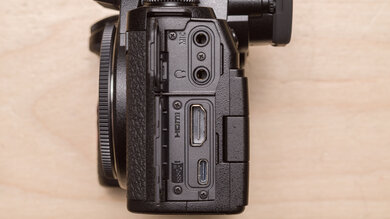The Panasonic LUMIX S5 IIX is a full-frame mirrorless camera and the more video-oriented counterpart to the Panasonic LUMIX S5 II. Outwardly, the S5 IIX is nearly identical, distinguished only by its shadowy all-black finish. Like the S5 II before it, it features phase-detection AF in contrast to older Panasonic models that relied on outdated contrast-detection technology. However, there's a bit more under the hood here for videographers and video shooters, with All-I codec support, the option to record externally to an SSD, along with internal ProRes support and external RAW video output. This is still a hybrid camera, though, with a high-resolution full-frame sensor that can capture fantastic images, a high-res viewfinder, in-body image stabilization (IBIS), and dual SD card slots.
Our Verdict
The Panasonic LUMIX S5 IIX is good for travel photography if you don't mind a larger camera. This isn't the most portable option, but the image quality you'll get out of it is excellent, and it has a decent autofocus system to boot. However, the advanced video-oriented features of this camera make it highly overkill for travel photography needs, and it doesn't have the longest battery life.
Excellent overall image quality.
Decent autofocus.
Not very portable.
Video features are overkill if your primary focus is photography.
Limited CIPA-rated battery life.
The Panasonic LUMIX S5 IIX is excellent for landscape photography, primarily because of its amazing image quality. Its sensor captures a very wide dynamic range, and it does a good job of managing noise levels in low light, making it well-suited to images in tricky lighting conditions or scenes with varying luminance levels. It's also a very well-built camera, with excellent ergonomics. However, it doesn't have the longest battery life, and its video-leaning design means it isn't the best option if your primary focus is landscape photography.
Fantastic dynamic range.
Excellent overall image quality.
Not very portable.
Video features are overkill if your primary focus is photography.
Limited CIPA-rated battery life.
The Panasonic LUMIX S5 IIX is good for sports and wildlife photography, though this isn't its primary intended usage. Among modern hybrid cameras, it doesn't have the fastest mechanical burst rate, and though it's much quicker in e-shutter mode, the camera also struggles with rolling shutter, which can introduce artifacts with very quick subjects. The camera's autofocus is also just decent. It does quite well in most scenarios but isn't class-leading when it comes to tracking very quick moving subjects. Its image buffer can also take a very long time to empty once full.
Excellent overall image quality.
Decent autofocus.
Video features are overkill if your primary focus is photography.
Doesn't have the fastest mechanical burst rate.
Limited CIPA-rated battery life.
Heavy rolling shutter effect.
The Panasonic LUMIX S5 IIX is overkill for vlogging, but it's a very good video camera in general, so it may suit your needs if you need advanced video features, like internal 10-bit 4:2:2 Log recording and ProRes formats. Beyond that, video quality is fantastic, and its fully articulated screen allows you to monitor yourself while recording. It's also equipped with a full suite of inputs to connect any videography peripherals you need, like an external mic or monitor. Lastly, in-body image stabilization makes it easier to capture smooth handheld footage.
In-body image stabilization.
Wide range of recording options.
Fully articulated screen.
Autofocus is very reliable for video work.
Heavy rolling shutter effect.
The Panasonic LUMIX S5 IIX is a fantastic option for studio video. It supports a wide array of video recording formats, codecs, and resolutions, including 6k open gate recording, low compression All-I codecs, and 4k at up to 60p. With an external SSD, you can also capture ProRes 422 and 422 HQ codecs, while connecting an external recorder allows you to capture RAW video. Video quality is fantastic, with excellent dynamic range and a clean, detailed image. Its autofocus also works remarkably well in video mode. Aside from its fantastic array of recording options and excellent video performance, it's also designed with video in mind, with built-in fans to reduce the risk of overheating, a fully articulated screen, full HDMI port, and mic and headphone jacks. Having said that, the camera's sensor readout speed isn't the fastest, so rolling shutter can be an issue with pans or quick camera movements.
Wide range of recording options.
Supports direct recording to an external SSD.
Full suite inputs and outputs.
Excellent video dynamic range.
Built-in heat vents to mitigate overheating.
Autofocus is very reliable for video work.
Heavy rolling shutter effect.
The Panasonic LUMIX S5 IIX isn't designed to record POV action video, but it's a great option for recording action from afar. It has a wide range of resolution and frame rate options, including a dedicated Slow & Quick mode that lets you capture slow-motion footage in-camera. The in-body image stabilization also works well to steady camera movements. That said, it isn't very portable. Its sensor also introduces heavy rolling shutter distortion with quick camera movements.
In-body image stabilization.
Wide range of recording options.
Autofocus is very reliable for video work.
Heavy rolling shutter effect.
The Panasonic LUMIX S5 IIX captures excellent RAW image quality. It has a very wide dynamic range to capture more highlight and shadow detail in high-contrast scenes. It also resolves fine detail very well, giving you some cropping leeway. Finally, noise handling is good, so files are relatively clean even in low light situations.
Fantastic dynamic range.
Good noise handling.
Visibly sharp images.
Performance Usages
Changelog
-
Updated Apr 09, 2025:
We added mention of the recently reviewed Blackmagic Pocket Cinema Camera 6K G2 in the Video Features box.
- Updated Apr 03, 2025: Review published.
- Updated Mar 03, 2025: Early access published.
- Updated Feb 11, 2025: Our testers have started testing this product.
Check Price
Differences Between Sizes And Variants
We purchased and tested the Panasonic LUMIX S5 IIX in Black, which is the only color variant. Here's our unit's label.
You can buy the camera body on its own or bundled with a kit lens like the LUMIX S 20-60mm f/3.5-5.6 zoom lens or other lenses, depending on the retailer.
Popular Camera Comparisons
The Panasonic LUMIX S5 IIX is one of the best-value mirrorless cameras for videography and filmmaking. The value it offers for content creators and video shooters is hard to beat. It has features like ProRes codec support when recording to an SSD, open gate 6k recording, a wide range of frame rate options, and external RAW video output at a price that gives dedicated cine cameras like the Sony FX3 a run for their money. It also continues Panasonic's trend of implementing more effective phase-detection autofocus systems. While it's missing some features found on the newer Panasonic LUMIX GH7, like 32-bit float audio capability and internal RAW recording, this is the video-oriented Panasonic to get if you need full-frame video quality and low-light performance.
Though they share many similarities, the S5 IIX distinguishes itself from the Panasonic LUMIX S5 II with features like All-I support and SSD recording. If those features are important to you, it's worth the premium in price over the S5 II. However, if you don't need those features, the standard LUMIX S5 II offers arguably even better value for most hybrid photo/video shooters.
For more options, see our picks for the best video cameras, the best full-frame mirrorless cameras, and the best digital cameras we've tested.
The Panasonic LUMIX S5 IIX is the video-oriented twin to the Panasonic LUMIX S5 II. They share a lot in common, including identical bodies (though the S5 IIX is distinguished by an all-black finish), ergonomics, and build quality, as well as the same full-frame sensor, so you'll get identical image quality out of them. Beyond that, the S5 IIX has a few added features for advanced video shooters, like external SSD support, RAW video output, and low compression All-I codecs.
While they're both ostensibly hybrid photo/video cameras, the Sony α7 IV and the Panasonic LUMIX S5 IIX have different strengths. The Sony is the better overall camera for photography, with a more reliable photo AF system, a longer battery life, and faster burst shooting, not to mention a wider selection of affordable lenses. The Panasonic, by contrast, offers more for video shooters, with open gate 6k recording, external SSD support, ProRes codecs, and external RAW video output, as well as more video-centric design features like heat vents and a full-sized HDMI port.
The Panasonic LUMIX S5 IIX and the Canon EOS R6 Mark II are both excellent hybrid cameras. The Canon is better for photography, with faster burst shooting, a more effective autofocus system for photography, and a longer battery life. However, if you're more of a videographer, the S5 IIX offers more value, with advanced features like SSD recording, ProRes codecs, and better dynamic range in video.
The Panasonic LUMIX S5 IIX and the Panasonic LUMIX GH7 are both fantastic video-centric hybrid cameras, but the best one will depend on your needs and preferences. The GH7 has some more advanced features, like internal ProRes RAW recording, a CFexpress card slot that enables higher-bit rates, and more frame rate options, including uncropped 4k 120p. Rolling shutter is also less of an issue on its smaller Micro Four Thirds sensor, and equivalent lenses are more compact. That said, if you don't need any of those added features and you'd rather have the better dynamic range and noise handling of a full-frame sensor, you can't go wrong with the S5 IIX.
Test Results

The Panasonic LUMIX S5 IIX is the same size as the Panasonic LUMIX S5 II. It isn't the smallest or lightest camera, but it's still fairly portable for its class.
Likewise, the camera's build quality is identical to the Panasonic LUMIX S5 II, but aesthetically, the S5 IIX is differentiated by an all-black finish, including a blacked-out LUMIX logo on the front and blacked-out dial inlays with matte-finish buttons and dials.
Overall, the camera feels very sturdy, with premium materials, including a magnesium alloy body, weather-sealing, solid input, SD card compartment, and battery compartment covers. The shoulder strap attachment anchors are fixed to the body and won't rattle around while recording video, and the camera includes heat vents around the viewfinder.
The Panasonic LUMIX S5 IIX has fantastic ergonomics. The button layout and controls are identical to the Panasonic LUMIX S5 II, and they're well-placed, with plenty of customizable dials and buttons that make it easy to adjust settings and tailor the shooting experience to your preferences. The back of the camera includes a large thumb rest, and it's easy to reach the AF thumb stick, buttons, and dials without pressing something unintentionally. The hand grip is also large and deep, with a comfortable molded grip and robust textured rubber coating that feels secure in the hand.
The electronic viewfinder (EVF) carries over from the Panasonic LUMIX S5 II, with the same 3.68 million-dot resolution. It's sharp and clear, and the eyecup around the viewfinder is large and feels comfortable, if a bit firmer than the one on the S5 II.
The Panasonic LUMIX S5 IIX uses a fully articulated display. It has a high resolution for clear image playback and gets very bright, so glare is unlikely to be an issue when shooting outdoors.
The menu system is fantastic. Settings are clearly organized and labeled, making it easy to find what you're looking for. You can also create a custom menu for all of your most-used settings, and there are plenty of customization options, including for the quick menu. There are also some nice quality-of-life touches that make it easier to navigate. For example, when selecting from the many resolution and frame rate options, you can filter the settings by resolution, frame rate, or codec to find the settings you need more easily.
The Panasonic LUMIX S5 IIX is compatible with both the older LUMIX Sync app and the newer LUMIX Lab app. LUMIX Lab is intended to be a one-stop shop not only for transferring files to your smartphone, editing, and sharing them directly to social media, but also for editing and uploading custom LUTs and sharing them with other creators on the platform.
The Panasonic LUMIX S5 IIX uses the same full-frame sensor as the Panasonic LUMIX S5 II, with a dual native ISO design. You can set which ISO range to use, between 'LOW,' which natively covers ISO 100-800, and 'HIGH,' which covers ISO 640-51200, in photo mode. In video mode, the native ISO depends on what mode and shooting format you use, with native ISO settings as follows:
| Setting | Native ISO | Low | High |
|---|---|---|---|
| Normal | 100, 640 | 100-800 | 640-51200 |
| V-Log | 640, 4000 | 640-5000 | 4000-51200 |
| HLG | 400, 2500 | 400-3200 | 2500-51200 |
| Cinelike D2 / Cinelike V2 | 200, 1250 | 200-1600 | 1250-51200 |
The camera's battery life is good overall, but its CIPA rating for photos is on the lower side. Rated for 370 shots on a full charge, it falls short of other full-frame hybrid cameras like the Sony α7 IV. However, setting the camera to 'Power Save LVF' mode bumps that CIPA rating up to over 1200 shots, depending on the type of SD card you use. Meanwhile, using the camera with an external SSD drops it to about 300 shots. All in all, these ratings should be taken with a grain of salt, as they don't necessarily align with real-world usage.
The camera's tested video battery life, on the other hand, is excellent. It can last for about two hours of 4k video recording, which is great, and you can extend the battery life by using a compatible and sufficiently powered external power supply if you need.
The camera's burst shooting is okay, but its mechanical burst rate falls a bit short of the standard set by current hybrid cameras, like the Nikon Z 6III, which shoots at a much quicker 14 fps. That said, burst shooting has always been a minor weak point of the S5 series, with the original Panasonic LUMIX S5 only managing a max of 6 fps. So this is an improvement generally. The S5 IIX also does much better with its electronic shutter, shooting at speeds up to approximately 30 fps.
Additionally, it has a pre-burst capture mode that lets you buffer shots with a half-press of the shutter button before saving a set number of frames after fully pressing the shutter. You can adjust the pre-burst time between 0.5s, 1.0s, and 1.5s before the shutter press. This feature is useful if you can't anticipate the exact moment a subject will move, such as when a bird will take flight.
The camera's buffer size is decent, though the number of RAW frames it can hold before filling up is on the smaller side. Unfortunately, the camera also takes a very long time to empty its buffer once full, which can slow you down significantly. JPEG, by contrast, isn't an issue, and you can effectively shoot indefinitely when shooting in JPEG format.
The Panasonic LUMIX S5 IIX has a decent AF tracking system. Like the Panasonic LUMIX S5 II, it uses phase-detection AF, and there are some improvements from that initial implementation. With firmware ver. 2.0, the camera includes automatic subject detection modes for a range of subjects, including human face/eye/body detection, as well as animal, motorcycle, and car detection.
Overall, the camera does a decent job of accurately tracking moving subjects in busy settings, and you can expect a solid keeper rate across a range of different shooting scenarios. That said, it doesn't perform nearly as well as the best AF implementations, like that of the Sony α7C II, for example.
If you aren't relying on tracking and use a single center focus point, the camera does a great job of keeping up with a moving subject, although it isn't as quick and seamless as cameras like the Sony α7 IV, for example. If you can keep your subject under the focus point, you can still expect the vast majority of your shots to be usable. We tested AF with the LUMIX S 20-60mm f/3.5-5.6 lens, but your mileage may vary depending on the lens you use.
The Panasonic LUMIX S5 IIX uses the same five-axis IBIS system as the Panasonic LUMIX S5 II, and it does an excellent job of steadying handheld photos. You can capture sharp images at very slow shutter speeds. We tested image stabilization using the LUMIX S 20-60mm f/3.5-5.6 lens, which doesn't have optical image stabilization. Note also that stabilization performance can vary drastically depending on your lens, focal length, and even the steadiness of your hands.
The camera's RAW dynamic range is fantastic, so it captures a very wide range of detail in high-contrast scenes. Even in dimmer lighting conditions, it retains detail well.
Note: Trying to process this camera's RW2 files led to unusable files when converted to TIFF format through LibRaw/Imatest. To get around this, we converted the RAW files to DNG before processing them in Imatest to get our data. For that reason, the RAW image quality results may not be totally accurate.
The camera is incredible at resolving fine detail. You can crop in quite a bit without losing too much visible sharpness.
Note: Trying to process this camera's RW2 files led to unusable files when converted to TIFF format through LibRaw/Imatest. To get around this, we converted the RAW files to DNG before processing them in Imatest to get our data. For that reason, the RAW image quality results may not be totally accurate.
The Panasonic LUMIX S5 IIX does a very good job managing noise levels in low light, so you'll get relatively clean images even when there's less available light.
Note: Trying to process this camera's RW2 files led to unusable files when converted to TIFF format through LibRaw/Imatest. To get around this, we converted the RAW files to DNG before processing them in Imatest to get our data. For that reason, the RAW image quality results may not be totally accurate.
Make no mistake, this is a feature-packed camera for video shooters. There's a lot of overlap with the Panasonic LUMIX S5 II, including 'open gate' 6k/30 fps recording in MOV and a range of other resolution and recording format options, like 16:9 5.9k, C4k, and 3.3k, not to mention 4:3 aspect ratio anamorphic modes. It supports Log recording in V-Log and captures 10-bit 4:2:2 footage internally. Where it starts to diverge from the S5 II is in its external video capabilities.
Unlike the S5 II, the S5 IIX can output video directly to an external SSD through USB-C. Using an SSD nabs you higher-quality 12-bit footage in Apple ProRes 422 or 422 HQ. The camera can also output RAW video via HDMI in either ProRes RAW or Blackmagic RAW, depending on the recorder, which the S5 II can only do with the purchase of an upgrade key. While purchasing that upgrade key for the S5 II gives it a lot of the same functionality as the S5 IIX, the main thing that sets the S5 IIX apart is support for less compressed All-Intra codecs and direct streaming capabilities over Wi-Fi. However, unlike dedicated cinema cameras like the Blackmagic Pocket Cinema Camera 6K G2, the S5 IIX can't record RAW video internally without an SSD.
Additionally, firmware ver. 2.2 adds 'Crop Zoom' and 'Hybrid Zoom' features. Crop Zoom crops out a portion of the full image and enhances it without degrading image quality, which can be handy if you're using a prime lens and need to use a tighter crop. Hybrid Zoom takes advantage of the Crop Zoom feature by seamlessly integrating optical zoom with the Crop Zoom feature to allow you to zoom past the lens's focal length into electronic zoom using the zoom ring. However, there are limits to how much you can crop, depending on the recording format and resolution you use.
Note that the camera warns that its cooling fan can be picked up by the camera's built-in microphone, especially in its highest 'Fast' setting. While this won't be an issue in most cases, particularly if you use an external microphone, it's something to be aware of when relying on the internal mic and recording over long sessions or in extreme conditions when you might need to set the fan to 'Fast.'
Unlike the Panasonic LUMIX S5 II, this model supports All-I codecs, allowing you to capture higher-quality, low-compression video in MOV format.
The camera can capture 4k video at up to 60 fps, although 60 fps is limited to an APS-C crop.
There's a dedicated S&Q (Slow & Quick) mode, which lets you capture 4k or DCI 4k video at up to 60 fps and output the video at either 30 fps (2x slow) or 24 fps (2.5x slow).
The Panasonic LUMIX S5 IIX's internal recording features are fantastic. It can capture remarkably high bit rates, with the option to record 10-bit 4:2:2 V-Log footage internally. There's no recording time limit in 4k, but when recording in 6k MOV, the camera stops recording after 30 minutes in 30 fps or after 40 minutes in 24 fps. Thankfully, the camera's thermal management is great, aided by the built-in heat vents, effectively preventing overheating in 4k.
The autofocus is incredibly effective in video mode. The same subject detection modes available in photo mode are also available in video mode, so you can track a wide range of subjects. When tracking moving human subjects, the camera rarely misses focus and transitions are smooth and quick, even when the subject moves around or in and out of frame. The more basic object/general subject tracking is near seamless as well.
The Panasonic S5 IIX captures fantastic 4k video quality. The image looks very sharp, with excellent dynamic range and minimal noise, even in low light. You can compare the quality to some of the other recording options below:
- 6k open gate: Test Scene Extract
- 5.9k 30p (16:9): Test Scene Extract
- 4k 60p (APS-C crop): Test Scene Extract
- 3.8k 30p (MP4 Lite): Test Scene Extract
- 4k Crop Zoom (20mm crop zoomed 1.5x to 30mm): Test Scene Extract
True to advertising, the Crop Zoom function hardly impacts the image quality of the video, making it very useful in cases where you want to zoom in but your optical zoom is limited.
There's heavy rolling shutter effect in 4k, which is unfortunate. It's more noticeable than on the Panasonic LUMIX GH7, for example, but it makes sense given the larger sensor. Rolling shutter is even more pronounced in 6k open gate, as seen in this sample video, with a 9.67º distortion angle, and in 5.9k, as seen in this sample video, with a 8.67º angle. Using the Crop Zoom feature, by contrast, improves it somewhat, with a 5.00º distortion angle when shooting at a 30mm focal length and using a 1.55x crop, for example. You can see that sample video as well.
In 1080p, the Panasonic S5 IIX records at up to 120 fps without a crop, which is great for capturing high-speed footage. In S&Q (Slow & Quick) mode, you can also capture slow-motion 1080p footage at up to 180 fps, with the option to slow it down to 60 fps (3x slow), 30 fps (6x slow), or 24 fps (7.5x slow).
The camera can capture very high bit rates in 1080p. While you'll need to record to an SSD to get ProRes codecs in 4k, the camera can record ProRes FHD internally, which is great. We recorded bit rates of around 454Mbps when shooting in ProRes 422 HQ in FHD at 60 fps and a minimum of 121Mbps in ProRes 422 at 24 fps. Note that the bit rate noted above was recorded when shooting in FHD MOV All-I, while the minimum was recorded in LongGOP. Also, 10-bit 4:2:2 color is only available in MOV format; any MP4 recording options are limited to 8-bit 4:2:0.
The autofocus is incredibly effective in video mode. The same subject detection modes available in photo mode are also available in video mode, so you can track a wide range of subjects. When tracking moving human subjects, the camera rarely misses focus and transitions are smooth and quick, even when the subject moves around or in and out of frame. The more basic object/general subject tracking is near seamless as well.
The FHD video quality is excellent. The image is sharp and detailed, with great low-light performance. You can compare it to a couple of other FHD recording options below:
- FHD 120p: Test Scene Extract
- FHD Crop Zoom (20mm x1.5 = 30mm): Test Scene Extract
There's noticeably less rolling shutter effect in 1080p, but it's still not great. You'll see some skewing with quick camera pans or movement. It's a bit improved with the Crop Zoom function, as you can see in this sample video, where the distortion angle is about 4.00º when using a 2.3x crop on 20mm to get an effective focal length of 46mm.
The Panasonic LUMIX S5 IIX has excellent dynamic range in video mode. The total dynamic range it captures above the background floor isn't the highest, falling short of models like the Fujifilm X-H2S, but it has a very wide usable dynamic range when taking stricter noise thresholds into account. You'll have the widest usable dynamic range at V-Log's base ISO of 640, but there's also a noticeable bump at ISO 4000, which is the second native ISO, giving you extra flexibility in low-light conditions.
Tested settings:
- Resolution: 4k
- Frame Rate: 30 fps
- Log Format: V-Log
The Panasonic LUMIX S5 IIX has a full suite of inputs and outputs, including a full-sized HDMI port, which is great, as well as USB-C for charging, power delivery, file transfer, and SSD support. It also has both a mic and headphone jack, plus, there's a remote input.
It also has a built-in streaming encoder, which allows for wireless streaming functionality over Wi-Fi or by tethering the camera to your phone via USB.

